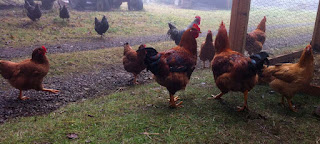After our Thanksgiving break, the concrete was set and ready for posts. We went 8' high on the short end, 10' on the high.
Hank identified the shortest post, and used a straight 2X4 to mark the other posts to the right height. He cut them to level with his skill saw.
If you are going to have to work in an active pasture, freezing weather can be a nice thing; keeps all the muck nice and firm.
With the posts all the same height, we screwed plywood gussets on top of the outside posts to hold the beams in place. The structure is 20' wide so we were able to use a single piece of wood for each beam.
Once the beams were all up we squared the building the best we could and attached braces to keep it all in place.
One of the big things I have learned from Hank is to do things on the ground that you would rather not do in the air. For instance, while the beams were on the ground he marked where each rafter would go.
In the shot above, he snugged all the rafters together on a work table, squared the ends, and cut the rafter-tails on all of them at once. He then marked each rafter on the bottom where it would sit on the beam, and the layout on the top where the skip sheeting would go. This made it so we knew just where each board went when we were standing on top of the ladders.
We toe-screwed the beams and posts together, then added strapping to keep them in place.
After the rafters went up, we used hurricane straps to keep them in place, and blocking to keep them upright.
We used a come-along to pull the structure into square. It was not off by much, only about 3/8 of an inch, but we got it just right.
1X4 skip sheeting came next, tying it all together nicely.
Continuing the theme of doing ground work, I marked the tin roofing where we wanted the screws to go, and punched holes with a nail set. This spared the effort of forcing the nail through the tin while standing on the roof.
We used used un-grooved T1-11 plywood for the sides/sheer panels. Phoebe is a fan of letting the light in, as we did in the
Hay House. It gave the barn a really nice, open and airy feeling.
We continued that idea on the loafing shed, so we can see in, the horses can see out, and it is nice and bright inside.
The high side faces east, not a big weather consideration here, but she suggested closing it in a little anyway. A couple of 2X6s on the inside will keep the horses from pushing the plywood out. Stall mats and a 4' gate finished it off.
The weather had been unseasonably dry that December, with the rain holding off until the shed was finished. Rio was a little spooky when he first came in, just before Christmas. In a few days, though, he was right at home. In addition to keeping him warm and dry, his hay stays dry, so we are wasting less of it.
Since he is a mustang from Eastern Oregon, it could be argued that standing outside in the milder Western Oregon winter is not big deal for him. So why go through the effort and expense to build him a grade A horse house?
First, just because he can stand in the rain doesn't mean he should. As a city boy at heart, I have the idea that everyone should have a dry place when they want it. Second, mud control is one of Phoebe's big things. So for both of us, a wet horse standing in deep mud is not an acceptable approach to animal owning. Since we have committed to having horses, we need to do what we can to treat them right.
Finally, we are trying to build infrastructure that will allow us to follow our interests, and what the land teaches us, to discover what the Homestead is best suited for.
This may well involve more animals. Could be more horses, a goat or two to help with the blackberries, or a couple calves to try raising beef; we are not sure. But we do know that before we get serious about animals we need good fences and safe, dry shelter. The loafing shed is the next step in the progression. We don't really know where we are going, but this is one more important step on the way.



























































